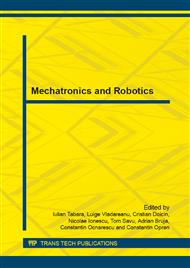[1]
C. W, Richards, Agile manufacturing: beyond lean? Production and Inventory Management Journal 37(2) (1996) 60-64.
Google Scholar
[2]
S. Ah., Kioon, A. A. Bulgak, T. Bektas, Integrated cellular manufacturing systems design with production planning and dynamic system reconfiguration, European Journal of Operational Research 192(2) (2009) 414-428.
DOI: 10.1016/j.ejor.2007.09.023
Google Scholar
[3]
Y. Won, K. R. Currie, An effective p-median model considering production factors in machine cell/part family formation, Journal of Manufacturing Systems, 25(1) (2006) 58-64.
DOI: 10.1016/s0278-6125(06)80033-6
Google Scholar
[4]
J. Tompkins, et al. Facilities planning, Wiley (2003).
Google Scholar
[5]
M. A., El – Baz, A genetic algorithm for facility layout problems of different manufacturing environments, Computers and Industrial Engineering, 47(2-3) (2004) 233-246.
DOI: 10.1016/j.cie.2004.07.001
Google Scholar
[6]
W. – C., Chiang, C., Chiang, Intelligent local search strategies for solving facility layout problems with the quadratic assignment problem formulation, European Journal of Operational Research 106(2-3) (1998) 457-488.
DOI: 10.1016/s0377-2217(97)00285-3
Google Scholar
[7]
T. M., Allegri, Material Handling: Principles and Practices, Van Nostrand, New York (1980).
Google Scholar
[8]
S. S., Heragu, Facilities Design, PWS Publishing Company, Boston, MA (1997).
Google Scholar
[9]
U. Wemmerlov, D. J. Johnson, Empirical findings on manufacturing cell design, International Journal of Production Research 38(3) (2000) 481-507.
DOI: 10.1080/002075400189275
Google Scholar
[10]
I. Mahdavi, B. Mahadevan, CLASS: An algorithm for cellular manufacturing system and layout design using sequence data, Robotics and Computer-Integrated Manufacturing, 24 (2008) 488–497.
DOI: 10.1016/j.rcim.2007.07.011
Google Scholar
[11]
T. L. Urban, W. C. Chiang, R. A. Russell, The integrated machine allocation and layout problem, International Journal of Production Research 38(13) (2000) 2911-2930.
DOI: 10.1080/00207540050117369
Google Scholar
[12]
Sh. Ariafar, N. Ismail, An improved algorithm for layout design in cellular manufacturing systems, Journal of Manufacturing Systems, 28 (2009) 132–139.
DOI: 10.1016/j.jmsy.2010.06.003
Google Scholar
[13]
A. J. G. Babu, D. Yao, An expert facility layout system: an object-oriented approach, International Journal of Computer Applications in Technology 9(2-3) (1996) 131-143.
Google Scholar
[14]
B. Mocan, M. Fulea, E. Brad, S. Brad, State-of-the-art and proposals on reducing energy consumption in the case of industrial robotic systems, Proceedings of the 2014 International Conference on Production Research – Regional Conference Africa, Europe and the Middle East, Cluj-Napoca, Romania, 1-5 July (2014).
Google Scholar
[15]
T. C. Koopmans, M. J. Beckman, Assignment problems and the location of economic activities, Econometrica, 25 (1957) 53–76.
DOI: 10.2307/1907742
Google Scholar
[16]
S. Schockaert, P. D. Smart, F. A. Twaroch, Generating approximate region boundaries from heterogeneous spatial information: An evolutionary approach, Information Sciences, 181 (2011) 257–283.
DOI: 10.1016/j.ins.2010.09.021
Google Scholar
[17]
X. U. Gang, G. Lazaros, Process plant layout using an improvement-type algorithm, Chemical Engineering Research and Design, 87 (2009) 780–788.
DOI: 10.1016/j.cherd.2008.12.004
Google Scholar
[18]
H. D. Sherali, B. M. P. Fraticelli, R. D. Meller, Enhanced model formulations for optimal facility layout, Operations Research 51 (2003) 629–644.
DOI: 10.1287/opre.51.4.629.16096
Google Scholar
[19]
L. Caccetta, Y. S. Kusumah, Computational aspects of the facility layout design problem, Non-Linear Analysis 7 (2001) 5599–5610.
DOI: 10.1016/s0362-546x(01)00662-9
Google Scholar
[20]
H. Samarghandi, K. Eshghi, An efficient Tabu algorithm for the single row facility layout problem, European Journal of Operational Research, 205 (2010) 98–105.
DOI: 10.1016/j.ejor.2009.11.034
Google Scholar
[21]
L. Al - Hakim, On solving facility layout problems using genetic algorithms, International Journal of Production Research, 38 (2000) 2573–2582.
DOI: 10.1080/00207540050031922
Google Scholar
[22]
M. A. El - Baz, A genetic algorithm for facility layout problems of different manufacturing environments, Computers and Industrial Engineering, 47 (2004), 233–246.
DOI: 10.1016/j.cie.2004.07.001
Google Scholar
[23]
S. E. Kesen, S. K. Das, Z. Güngör, A genetic algorithm based heuristic for scheduling of virtual manufacturing cells (VMCs), Computers and Operations Research, 37 (2010) 1148–1156.
DOI: 10.1016/j.cor.2009.10.006
Google Scholar
[24]
X. Wu, C. H. Chu, Y. Wang, D. Yue, Genetic algorithms for integrating cell formation with machine layout and scheduling, Computers and Industrial Engineering, 53 (2007) 277–289.
DOI: 10.1016/j.cie.2007.06.021
Google Scholar
[25]
L.Y. Liang, W. C. Chao, The strategies of Tabu search technique for facility layout optimization, Automation in Construction, 17 (2008) 657–669.
DOI: 10.1016/j.autcon.2008.01.001
Google Scholar
[26]
D. Scholz, F. Jaehn, A. Junker, Extensions to STaTS for practical applications of the facility layout problem. European Journal of Operational Research, 204 (2010) 463–472.
DOI: 10.1016/j.ejor.2009.11.012
Google Scholar
[27]
Y. Hani, L. Amodeo, F. Yalaoui, H. Chen, Ant colony optimization for solving an industrial layout problem, European Journal of Operational Research, 183 (2007) 633–642.
DOI: 10.1016/j.ejor.2006.10.032
Google Scholar
[28]
M. Solimanpur, P. Vrat, R. Shankar, Ant Colony optimization algorithm to the inter-cell layout problem in cellular manufacturing, EJOR, 157 (2004) 592–606.
DOI: 10.1016/s0377-2217(03)00248-0
Google Scholar
[29]
L. Chwif, M. R. P. Barretto, L. A. Moscato, A solution to the facility layout problem using simulated annealing, Computers in Industry, 36 (1998) 125–132.
DOI: 10.1016/s0166-3615(97)00106-1
Google Scholar
[30]
M. Mir, M. H. Imaam, A hybrid optimization approach for layout design of unequal-area facilities, Computers and Industrial Engineering, 39 (2001) 49–63.
DOI: 10.1016/s0360-8352(00)00065-6
Google Scholar
[31]
M. C. González-Cruz, E. Gómez-Senent Martínez, An entropy-based algorithm to solve the facility layout design problem, Robotics and Comp. Integrated Manufacturing 27(1) (2011) 88-100.
DOI: 10.1016/j.rcim.2010.06.015
Google Scholar
[32]
A. Sadrzadeh, A genetic algorithm with the heuristic procedure to solve the multi-line layout problem, Computers & Industrial Engineering, 62(4) (2012) 1055-1064.
DOI: 10.1016/j.cie.2011.12.033
Google Scholar
[33]
G. C. Armour, E. S. Buffa, T. E. Vollmann, Allocating facilities with CRAFT, Harvard Business Review, 42 (1964) 136–158.
Google Scholar
[34]
A. Hadi-Vencheh, A. Mohamadghasemi, An integrated AHP–NLP methodology for facility layout design, Journal of Manufacturing Systems, 32(1) (2013) 40-45.
DOI: 10.1016/j.jmsy.2012.07.009
Google Scholar
[35]
M. Braglia, S. Zanoni, L. Zavanella, Layout design in dynamic environments: Strategies and quantitative indices, International Journal of Production Research, 41(5) (2003), 995–1016.
DOI: 10.1080/00207540210162983
Google Scholar


